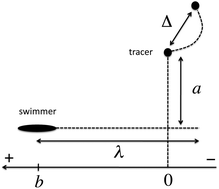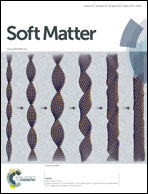Enhanced diffusion of tracer particles in dilute bacterial suspensions
Abstract
Swimming bacteria create long-range velocity fields that stir a large volume of fluid and move around passive particles dispersed in the fluid. Recent experiments and simulations have shown that long-time mean-squared displacement of passive particles in a bath of swimming bacteria exhibits diffusive behaviour with an effective diffusion coefficient significantly larger than its thermal counterpart. A comprehensive theoretical prediction of this effective diffusion coefficient and the understanding of the enhancement mechanism remain a challenge. Here, we adapt the kinetic theory by Lin et al., J. Fluid Mech., 2011, 669, 167 developed for ‘squirmers’ to the bacterial case to quantitatively predict enhanced diffusivity of tracer particles in dilute two- and three-dimensional suspensions of swimming bacteria. We demonstrate that the effective diffusion coefficient is a product of the bacterial number density, their swimming speed, a geometric factor characterising the velocity field created by a single bacterium, and a numerical factor. We show that the numerical factor is, in fact, a rather strong function of the system parameters, most notably the run length of the bacteria, and that these dependencies have to be taken into account to quantitatively predict the enhanced diffusivity. We perform molecular-dynamics-type simulations to confirm the conclusions of the kinetic theory. Our results are in good agreement with the values of enhanced diffusivity measured in recent two- and three-dimensional experiments.


 Please wait while we load your content...
Please wait while we load your content...